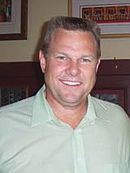199,845 196,283 Start date November 7, 2006 | 49.16% 48.29% | |
 | ||
Winner Jon Tester | ||
The 2006 United States Senate election in Montana was held November 7, 2006. The filing deadline was March 23; the primary was held on June 6. Incumbent Republican U.S. Senator Conrad Burns was running for re-election to a fourth term, but was defeated by Democrat Jon Tester by a margin of 0.87%, or 3,562 votes out of 406,505 votes.
Contents
Background
Burns was first elected as a United States Senator from Montana in 1988, when he defeated Democratic incumbent John Melcher in a close race, 51% to 48%. Burns was re-elected 62.4% to 37.6%, over Jack Mudd in the Republican Revolution year of 1994. In 2000, Burns faced the well-financed Brian Schweitzer whom he beat 50.6% to 47.2%.
In 2000, George W. Bush carried Montana 58% to 33% in the race for President, but Burns won by 3.4%. Since the direct election of Senators began in 1913, Burns is only the second Republican Montana has elected to the U.S. Senate. Also, for thirty-two straight years, 1952 to 1984, Montana elected only Democratic Senators.
Burns' involvement in the Jack Abramoff scandal made him vulnerable. A SurveyUSA poll released in March 2006 found that 38% of Montanans approved of him, while 52% disapproved of him. Polls against leading Democratic candidates had him below his challengers.
Candidates
Campaign
On May 31, 2006, Richards, citing the closeness of the race, and his own position (third) in the polls, withdrew from the race, and threw his support to Tester. Morrison started off strong in the race for the Democratic nomination for Senator, collecting $1.05 million as of the start of 2006, including $409,241 in the last three months of 2005. but Morrison’s advantages in fundraising and name identification did not translate into a lead in the polls. Later, the race was called a "deadlock," but Tester continued to gather momentum.
Candidates
Candidates
Campaign
The race was expected to be close, due to Burns' previous narrow winning margins and recent political scandal involving him personally; Republican incumbents everywhere were facing more challenging races in 2006 due to the waning popularity of Congress and the leadership of President George W. Bush. In July 2006, the Rasmussen report viewed Burns as the "second most vulnerable Senator seeking re-election this year (Pennsylvania’s Rick Santorum was still the most vulnerable)."
Senator Conrad Burns of Montana faced a strong challenge from Brian Schweitzer in 2000, being re-elected by 3.4% in a state that went for Bush twice by margins of over 20%. This, combined with the increasing strength of the state Democratic party and accusations of ethical issues related to the Jack Abramoff scandal, made this a highly competitive race.
On July 27, Burns was forced to apologize after he confronted out of state firefighters who were preparing to leave Montana after helping contain a summer forest fire and directly questioned their competence and skill; Burns was strongly criticized.
On August 31, in a letter faxed to the office of Montana governor Brian Schweitzer, Burns urged the governor, a Democrat, to declare a fire state of emergency and activate the Montana Army National Guard for firefighting. Schweitzer had already declared such a state of emergency on July 11 — thus, activating the Montana Army National Guard. He issued a second declaration on August 11. A Burns spokesman said the senator was "pretty sure" Schweitzer had already issued such a disaster declaration, but just wanted to make sure. "The genesis of the letter was just to make sure that all the bases were covered," Pendleton said. "This is not a political football. It’s just a cover-the-bases letter and certainly casts no aspersions on the governor."
Results
Due to errors with polling machines the Montana count was delayed well into Wednesday 8 November. The race was too close to call throughout the night and many pundits predicted the need for a recount. After a very close election, on November 9, incumbent Conrad Burns conceded defeat.
Just before 11:00 AM (MST) on November 8, Jon Tester was declared Senator-elect for Montana in USA Today. At 2:27 PM EST on November 8, CNN projected that Jon Tester would win the race.
Under Montana law, if the margin of defeat is more than 0.25% but less than 0.5%, the losing candidate can request a recount if they pay for it themselves. However, this election did not qualify for a recount because the margin was larger than 0.5%. Burns conceded the race on November 9, and congratulated Tester on his victory.
The race was the closest Senate election of 2006 in terms of absolute vote difference; the closest race by percentage difference was the Virginia senate election.
